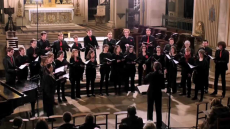
It is very difficult to compare Brahms to other composers due to his idiosyncratic style. This style however, was not always universally appreciated. In April 1984, a young Max Reger defended Brahms’ works; ‘Although the music may at first be difficult to grasp, Brahms has nevertheless come so far that all truly intelligent and sensitive musicians, unless they want to make fools of themselves, must acknowledge him as the greatest of living composers.’ This definitely illustrates the polarising of opinions regarding music at the time; people preferred either Brahms or Wagner, with an increasing amount being drawn to the latter, ‘to the brighter glow, to the phenomenon of Wagnerism in European music.’ The central cause of conflict between the two groups was that of tradition and new musical concepts. Due to Brahms’ moving away from some traditional ideas, such as Beethoven’s idea of what should be the focus of the composition, he was regarded as being of the school of ‘new German’ music, so conservative critics disapproved. However, as we have seen, Brahms frequently used Bach’s traditional counterpoint method, so in fact, it is quite difficult to label Brahms as either traditional or non-traditional.
Brahms’ vocal compositions are also of great interest. For example, in Nachtwache I, we have an odd make-up of the choir, with one soprano, two altos, one tenor and two basses, and then we see a very deliberate antiphonal structure, with different voices singing alternate phrases, like they are all syncopating one another. Essentially, this piece is for two voices, the soprano and the tenor, and the other voices effectively serve as a choir, exhibiting ‘little individuality in a melodic sense, and functioning harmonically, merely support the melody.’ This may sound like a dull composition, however, on the contrary, this homophonic texture is perfectly befitting of the poetic lyrics, which are very much from an individual’s perspective on love. Therefore, Brahms has cleverly used multiple voices and still created the effect of there being an interchange only between two.
Overall, I believe that Brahms’ use of harmony and structure should be regarded as some of the best of all the composers, partially due to his fusion of both new and old techniques, which he so flawlessly melds together. Equally, his bold new ideas, such as using a symphony to depict nature, clearly set him apart from others. He manages to maintain fluidity throughout his works, even with sparse instrumental textures and syncopations; he creates such complex melodies with beautifully executed harmonies that the pieces are all incredibly cohesive, even when there is a ‘conflict’ present, before he brings each piece to a wonderful resolution. Again, this is in a completely different way to other composers, as he reuses and focuses on the themes he has written rather than feeling he has to create further developments, and as such, gives each work a sense of familiarity to the listener. The instrumentation that Brahms works with is just as innovative; his incredible use of the human voice, and wonderful dialogues between such different instruments such as trombones and violins surely make his works some of the most successful and interesting of all the composers.
Image1: https://www.youtube.com/watch?v=2UAQdCecEPw

0 Comment:
Be the first one to comment on this article.